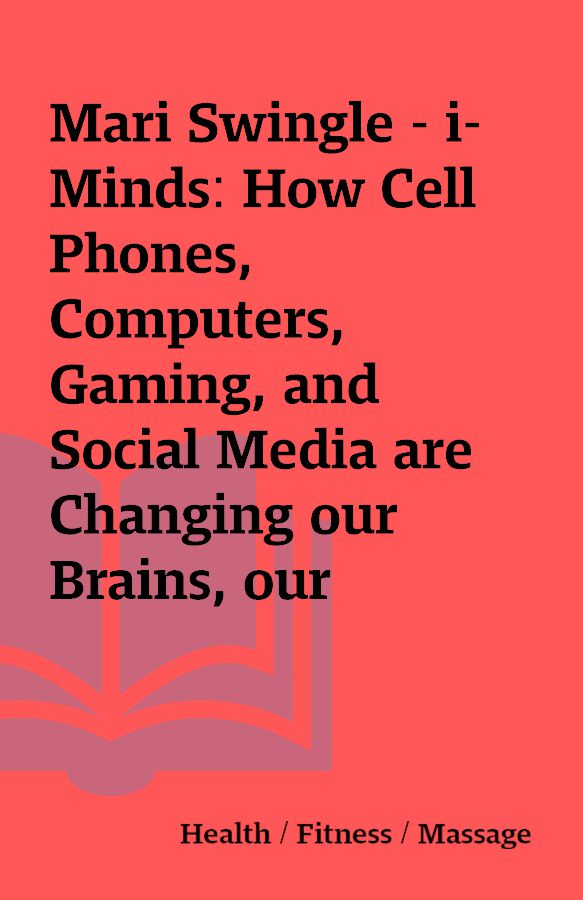Mari Swingle – i-Minds: How Cell Phones, Computers, Gaming, and Social Media are Changing our Brains, our Behavior, and the Evolution of our Species
i-Minds by Mari K. Swingle
[1 Ebook – PDF,Epub]
Description
i-Minds: How Cell Phones, Computers, Gaming, and Social Media are Changing our Brains, our Behavior, and the Evolution of our Species by Mari Swingle2016 | ISBN: 0865718253 | English | 240 pages | PDF/EPUB | 2 MB/3 MBMany of us would no more go out without our cell phone than we would leave the house without clothes. We live our lives on social media, and PDAs, tablets, computers and other devices are completely integrated into our global culture. From connectedness to accessibility and instant access to information, a wealth of benefits accompanies this digital revolution. But what about the cost?Weaving together history, popular literature, media and industry hype, sociology and psychology, and observations from over eighteen years of clinical practice and research, Dr. Mari Swingle explores the pervasive influence of i-technology. Engaging and entertaining yet scientifically rigorous, i-Minds demonstrates:How constant connectivity is rapidly changing our brains What dangers are posed to children and adults alike in this brave new world The positive steps we can take to embrace new technology while protecting our well-being and steering our future in a more human directionThis extraordinary book is a virtually indispensable look at a revolution where the only constant is change—food for thought about which aspects of technology we should embrace, what we should unequivocally reject, and the many facets of the digital era that we should now be debating.Dr. Mari K. Swingle is a neurotherapist and behavioral specialist who practices at the highly-regarded Swingle Clinic. She holds a BA in Visual Arts, an MA in language education, and an MA and PhD in clinical psychology, and has won numerous awards for her post-doctoral work on the effects of i-technology on brain function. Editorial ReviewsReviewIn this meticulously researched and necessary book Mari Swingle shows how the i-world is hijacking young people’s minds and even their brains. Her practical advice guides us to become masters, not servants, of the technology we are bequeathing to our children. —Gabor Maté M.D., co-author, Hold On To Your Kids:Why Parents Need To Matter More Than Peers and author, In the Realm of Hungry Ghosts: Close Encounters with AddictionDr. Mari Swingle brilliantly explains how digital displays and social media are changing our brains by capturing our evolutionary survival patterns. i-Minds is a must read to understand the impact of our digital revolution and how to use it wisely. She explains why students’ attention spans have significantly decreased, ADHD, depression, impulsivity and anxiety have increased, and why students who take notes on digital devices in the classroom (tablets, smart phone or laptops) do significantly worse than those who still write notes on paper. —Erik Peper, PhD, Professor, San Francisco State University, President of the Biofeedback Federation of Europe, co-author, Fighting Cancer: A Nontoxic Approach to Treatment, author of the blog, The Peper Perspective-Ideas on illness, health and well-being.An eye-opener. This book left me speechless. i-Minds made me look inward at my own relationships with people and technology and consider whether I liked the impact instead of just blindly following it. —Rob Krall, host, Bottom up Radio; publisher, OpEdNews; and founder, organizer of the Winter Brain MeetingIn this age of screens we’re beset with a pack of new emotional and behavioral conundrums. Mari K. Swingle walks us through the fundamentals of these changes with a kindness and clarity I find deeply refreshing. i-Minds is a well-researched guide for teachers and parents keen on understanding the ramifications of our new media climate. —Michael Harris, author, The End of Absence: Reclaiming What We’ve Lost in a World of Constant ConnectionIn i-Minds, Mari K. Swingle offers exceptional insights into the emotional and behavioural problems that may arise from living in a 24/7 wired world. She also provides deep insights to those trying to help anyone who’s addicted to their digital devices. —Charlie Smith, Georgia Straighti-Minds is more than a book. It’s a tool to help us decide when screenbased devices are enriching our lives, and when they’re stealing it. If you’ve looked at your smartphone, checked your social media feed, or distracted your kid with an iPad today, you need to read this book right away.—Jon Cooksey, director, How to Boil a FrogA genuinely original position on a historically significant cultural issue…. A scientifically rigorous and philosophically challenging argument that digital media is not merely shaping culture, but also the very nature of the human brain. —Kirkus ReviewsThis book is a revolution. Dr. Mari Swingle pushes boundaries effectively without pointing fingers at any particular generation. She emphasizes that excessive technological use can put any age group at risk of developing behavioral issues, which is quite original compared to other authors who tend to accuse only the young of using too much i-tech…. Her findings are truly extraordinary. —San Francisco Book Review–This text refers to an alternate Paperback edition.From the Back CoverConstant connectivity is rewiring our brains – This is your survival guide for the digital era…Mari Swingle shows how the i-world is hijacking young people’s minds and even their brains. Her practical advice guides us to become masters, not servants, of the technology we are bequeathing to our children.—Dr. Gabor Maté M.D., co-author, Hold On To Your Kids: Why Parents Need To Matter More Than PeersAn eye-opener. This book left me speechless. i-Minds …made me look inward at my own relationships with people and technology and consider whether I liked the impact instead of just blindly following it.—Rob Krall, host, Bottom up Radio, publisher OpEdNewsMany of us would no more go out without our cell phone than we would leave the house without clothes. We live our lives on social media, and PDAs, tablets, computers and other devices are completely integrated into our global culture. From connectedness to accessibility and instant access to information, a wealth of benefits accompanies this digital revolution. But what about the cost?In i-Minds, author Dr. Mari Swingle explores the pervasive influence of i-technology, demonstrating:* How constant connectivity is rapidly changing our brains* What dangers are posed to children and adults alike in this brave new world* The positive steps we can take to embrace new technology while protecting our well-being and steering our future in a more human direction.Engaging and entertaining yet scientifically rigorous, this extraordinary book is an indispensable look at a revolution where the only constant is change—food for thought about which aspects of technology we should embrace, what we should unequivocally reject, and the many facets of the digital era that we should now be debating.…brilliantly explains how digital displays and social media are changing our brains by capturing our evolutionary survival patterns. A must read to understand the impact of our digital revolution and how to use it wisely.—Erik Peper, PhD, Professor, San Francisco State University and President, Biofeedback Federation of EuropeAbout the AuthorDr. Mari Swingle is a psychoneurophysiologist and learning and behavioral specialist who practices with the highly-regarded Swingle Clinic, which she cofounded with her father, Dr. Paul Swingle, who is considered to be one of the founding fathers of Clinical Psychoneurophysiology. She holds an MA and PhD in Clinical Psychology, an MA in Language Education, and a BA in Visual Arts. Dr. Mari, as she is known to her clients, is a BCIA Fellow and a Certified Neurotherapist. She has won awards for her post-doctoral work on the effects of i-technology on brain function. Dr. Mari presents her research and speaks regularly on the topic of i-media on the neurophysiology of children and adults.Excerpt. © Reprinted by permission. All rights reserved.IntroductionSocietal ShiftingEvery era has an innovation that changes the face of society: the way wethink, the way we act and interact as individuals, as a community, andas a culture. As the innovation is introduced, it tends to be greeted withelation. As the innovation becomes integrated and the first societalshifts become apparent, some start to question the balance of benefitand loss in the equation of change. We are now in such a place withdigital media.Cell phones, PCs, and the Internet are now completely integratedin global culture, i-culture: welcomed by most, resisted by some, theimpact apparent for all. There is great change for the better, but now, afew decades into the assimilation, there is also arguably evidence of anequally negative impact. The darker side of the digital era has emerged.Be it due to naïveté or denial, the negative influences of digitalmedia are expanding, blindly accepted by most — educators, business,parents, and partners, who later wonder what went terribly wrong. Thisbook will explore such changes and hopefully provide food for thoughton what we should embrace and accept, what we should unequivocallyreject, and what aspects of the digital era we should now be debating.The debate, unfortunately, often gets sidetracked into generationalarguments — a generational divide wherein the older complain of the younger becoming progressively stupid, rude, and isolating withi-tech at the expense of interpersonal or face-to-face relationships. Theyoung, like any generation before, equally find their pre–i-tech eldersignorant of advancement, judgmental, invasive, and abrasive in theirviews, feeling they should stop pontificating and get with the times.But we are all missing the point. By sticking staunchly to our positions,we risk missing the fine print: the subtle and not-so-subtle changes inhuman behavior and underlying brain function that are unequivocallychanging all that we are, and the world that we live in. Here we all oweit to ourselves, and the generations that will follow, to open our eyes,look up, and examine change in action, to arm ourselves with informationon who we are, and what we wish to become in this new, and yes,wonderful, i-mediated world….and now the dark side.First Hints of a ProblemOver the past two decades, a select group of scholars and health carepractitioners began to systematically note the emergence of a new setof issues seemingly associated with excessive usage and otherwise unhealthyapplications of i-technologies. Today the effects are confirmed,notably in the realms of sexuality, socialization, education, and failureto launch. For children, adolescents, and youth, excessive usage of digitalmedia is now highly associated with learning disabilities, emotionaldysregulation, as well as conduct or behavioral disorders. For adults, itis highly correlated with anxiety, depression, sexual dysfunction andsexual deviation, insomnia, social isolation, disaffected pair bonding,marital conflict, and compromised work performance. In clinical practice,I am also starting to note some rather frightening connectionswith thwarted emotional and cognitive development in the very young.Opening Our EyesI would like to think we are wiser now as a global culture, havinglearned from past mistakes, that we no longer blindly continue onpaths of innovation without looking up to examine the potential toll.My last eighteen years working in a clinical environment, however, are telling me otherwise. Unlike excessive consumption or abuse of othersubstances such as alcohol, food, or drugs, for many, the effects of excessiveusage of digital media are rarely perceived as contributing to,never mind as causing, a specific ailment, condition, or conflict.All this said, digital media is here to stay and has unquestionablyadvanced our world. It is not negative by nature. This is not the claimthat this book will make; not by far. But what the Internet and all digitalmedia give, they can also take away. How we use it, interact withit, and depend on it vis-à-vis our “real” world and real relationshipswithin are key.The questions we now need to start asking ourselves are not whatthe technologies are positively contributing, as these contributions arerather evident, but rather what the technologies are replacing or takingaway: an older technology, a behavior, a skill, a relationship, ourcompassion, values…intelligence? It is time to widen our focus to thebroader effects of i-technology in all the branches of our day-to-daylives. It is time to ask ourselves what i-media is truly facilitating.In This BookThis book is written from a therapist’s perspective. As a practicing clinician,I have based i-Minds upon what has passed my clinical floor:how i-media is affecting children, partners, family, learning. The listis long.Weaving through larger societal shifts, including history, researchand hard data, developmental theory, literature on brain function andmental illness, professional reflections, popular literature, and observationsfrom clinical practice, I will illustrate how the medium is influencingour thinking and our processing — our functioning as a whole.I will look at microcultures, such as high school and bullying, parentingcircles, and dating, as well as shifts in macroculture affectingwork, sexuality, mental health, learning, play, creative process, attachment,and development itself. I will explore the increase in apathy andgeneral hyperarousal in the masses associated with excessive applicationsof i-tech. I will also explore the extreme: a new and growingphenomenon threatening to become the addiction of the twenty-first century, referred to as Internet addiction (IA), digital addiction, or i-addiction.The i-phenomenon will be explored in tandem from three distinctangles.• First, I will explore the big picture of what is affecting us all, regardlessof age, gender, culture, or creed.• I will also present what appears to be generation specific — not exclusivelyby chronological age itself, but rather by age as it relates tothe rate of the assimilation of the technologies.• Lastly, I will discuss the effects of digital media in terms of level ofimmersion: the way, or more specifically the “why” and the “how,”some of us are using the medium to the inclusion or exclusion ofother activities or relationships.For those of you who are more scientifically or research oriented, supplementaldetails are presented in sections labeled Scientific Corner. Forthose of you who are not, these sections can be skipped without losingthe general flow. Definitions of some potentially unfamiliar terms andkey points will also be included within the text in italics.Interspersed throughout, I will sprinkle advice: solutions, options,and actions one can choose to follow if situations and vignettes seemall too familiar. My goal is to educate, to ensure that i-tech remains asolid complement to all that we are, integrated with but not overridingthe human element in cognition and development, work, industry, education,socialization, and play.Great BeginningsSubtle Shifts in BehaviorBut first, how did this all start?The World Wide Web, as we first called it, was a military innovationthat, when it crossed over into civilian life, was embraced as changingthe world only for the better. Indeed, in its beginnings, it was mostpositive. First gaining a foothold in academic communities in the early1990s, the Internet was the ideal tool for research and learning.1 Soon,no more restrictions on library hours, no more trudging across campusonly to find someone else had reserved the book or article you needed.It was also the ideal form of international communication. No morefallen land lines, outrageous telephone bills, and one could see, nevermind merely talk to, colleagues, friends, and family while traveling orstudying away from home.The Web, as promptly nicknamed, was a most novel and efficientform of communication; it was not location-specific, and was accessiblefor free with any PC and phone line. In the 1990s many of us had,and used, university-funded email and later messaging, as the mostefficient form of communication long before we had, or could afford,cell phones.It soon became apparent, however, that the Internet was also changing“local” behavior. In my own graduate school experience, friendsstarted sending diatribes of thought via email. Discussions we wouldusually have gathered for and debated over a coffee or a beer were nowsequential monologues sent via computer. Although initially most entertaining,some of us, including myself, noted the reduction of face-to-face social interaction and felt something was amiss. Although I didnot precisely see it for what it was at the time, I was remotely aware ofthe development of a bit of a void. I, for one, was missing the reward orpleasure of the face-to-face social engagement.Thereafter, some of us became quite engrossed in these great emaildialogues, others less — still choosing to gather weekly in person. Asmall and, at the time, barely notable division of social behaviors, andhence social circles, started within our tiny university network.Viewed in retrospect, my experience as a master’s student in themid-1990s was not unique. Very early on, anecdotal reports started toemerge that indeed the Internet was changing social behavior. A ratheramusing incident in circulation was how a group of international studentswas observed in a dorm, laughing and engaging, each with theirown PC, rather than socializing with each other. At the time, we foundthis behavior peculiar and, hence, the story amusing. Why would youchoose to play with a computer or communicate with others abroad,when you had friends, company, sitting right next to you? The end ofthe story was, for its time, a seemingly perfect double twist. Indeedthese students were socializing with each other. They were not engagingat all with friends from abroad, but rather with each other in thesame room via computer interface.At the time, the behavior raised some eyebrows, but was also simplyattributed to the harmless pursuit of novelty of the new medium.What we did not see, however, was that this was a great foreshadowingof things to come, something none of us, at the time, would everhave dreamed of. Now, merely twenty years later, this behavior is notunusual at all: digital interface has become the primary mode of communicationfor all youth.From Subtle to Extreme — First Hints of Problematic UsageBeyond amusement, very early on, it was noted that high Internet usagecould also have quite serious detrimental effects.2 Parallel to my owngraduate school observation of social division, for some, Internetusage was leading to social avoidance and isolation as opposed to broader socialization networks, albeit done under the precise illusion of communicationand social interaction.Similarly, in academia, the ideal tool for research and scholarshipwas negatively affecting academic performance and class attendance.Students were skipping class and handing in assignments late, havingstayed up too late playing or “researching” on the Web. For a selectgroup, time that was previously dedicated to work, school, chores, orsocial interaction with family, friends, and peers was now dedicated toInternet usage — to the neglect of other activities and interactions.The medium was showing potential to have exactly the opposite ofits intended effect: reducing, as opposed to broadening, the scope ofsocialization, work, scholastic and general life efficiency. For some academics,questions started to arise as to whether this form of excessiveInternet usage had the properties of addiction.3,4,5,6,7 The answer now,over twenty years later, is clearly “yes.”
You must be logged in to post a review.






Reviews
There are no reviews yet.